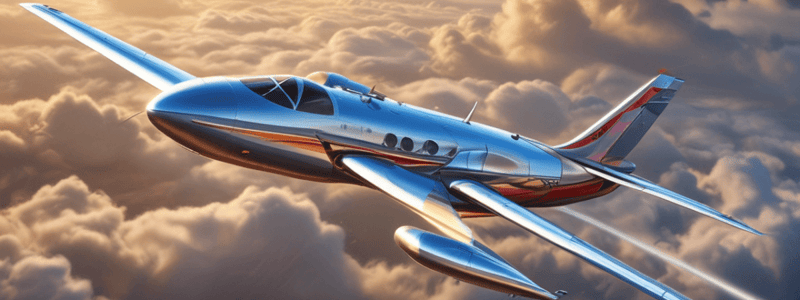Podcast
Questions and Answers
What is the primary reason for the increase in lift during ground effect?
What is the primary reason for the increase in lift during ground effect?
- Decrease in angle of attack
- Increase in airspeed
- Increase in throttle setting
- Restriction of wingtip vortices by the proximity of the ground (correct)
What can occur if a pilot fails to anticipate and manage the aircraft's behavior during landing in ground effect?
What can occur if a pilot fails to anticipate and manage the aircraft's behavior during landing in ground effect?
- A shorter landing roll
- Decreased drag
- Increased airspeed
- A longer landing roll (correct)
What is a potential hazard of relying on ground effect during takeoff?
What is a potential hazard of relying on ground effect during takeoff?
- Insufficient climb performance to continue to gain altitude (correct)
- Increased drag
- Decreased airspeed
- Reduced visibility
What adjustment is required when transitioning out of ground effect?
What adjustment is required when transitioning out of ground effect?
What is the result of ground effect on the handling characteristics of an aircraft?
What is the result of ground effect on the handling characteristics of an aircraft?
Why is it crucial for pilots to understand and adapt to ground effect?
Why is it crucial for pilots to understand and adapt to ground effect?
What can occur if a pilot reduces the throttle during landing in ground effect?
What can occur if a pilot reduces the throttle during landing in ground effect?
What is the primary benefit of ground effect during takeoff?
What is the primary benefit of ground effect during takeoff?
What can occur if a pilot fails to recognize the changes in handling characteristics during transition out of ground effect?
What can occur if a pilot fails to recognize the changes in handling characteristics during transition out of ground effect?
Study Notes
Ground Effect
- Ground effect occurs when an aircraft flies close to the earth's surface, altering aerodynamic forces acting on it, resulting in increased lift and reduced drag.
- Proximity to the ground restricts wingtip vortices, decreasing induced drag, and increases air pressure beneath the wings, boosting lift.
Impact on Takeoff
- Ground effect can assist takeoff by providing extra lift and reducing power required to get airborne.
- Pilots must recognize when the aircraft is in ground effect to avoid premature lift-off, which could lead to insufficient climb performance.
Impact on Landing
- Ground effect can present the illusion of a "cushion" of air, potentially leading to a longer landing roll if not anticipated and managed correctly.
- Pilots must adjust approach speed and descent rate to maintain control and make a smooth touchdown.
Aircraft Design Influence
- Low-wing aircraft are more influenced by ground effect than high-wing aircraft due to their proximity to the surface.
- Wing design, including aspect ratio and shape, affects the strength of ground effect.
Pilot Considerations
- Pilots must be aware of ground effect during takeoff and landing to anticipate changes in aircraft behavior and adjust accordingly.
- Practice float control during landing, familiarize yourself with specific aircraft performance charts, and anticipate adjustments needed as you rise above the ground.
Handling Characteristics
- Ground effect can significantly affect aircraft handling characteristics, particularly during critical phases of flight.
- Pilots must adapt to ground effect by recognizing changes in aircraft behavior and making adjustments to maintain control.
Studying That Suits You
Use AI to generate personalized quizzes and flashcards to suit your learning preferences.
Related Documents
Description
Learn about the essential concept of ground effect in aerodynamics, a critical aspect of flight for aspiring pilots. This module explores the complex interaction between an aircraft and its surroundings.



